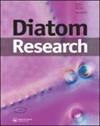关于神秘硅藻根管藻(Rhizosolenia dubia)及其与pseudoyxilla和Proboscia的关系,以及一新种Proboscia pinochoi sp. nov的描述。
IF 1.3
3区 生物学
Q2 MARINE & FRESHWATER BIOLOGY
引用次数: 1
摘要
Pyxilla吗?dubia最初被描述为来自日德兰半岛,但后来被转移到pseudoyxilla。然而,在相隔80多年的时间里,人们发现了两个具有管状异瓣体的神秘标本,其中一端是假根状瓣,另一端是根状瓣,这导致了一个新的组合,根状瓣。在此,我们使用光学和扫描电子显微镜详细记录了在日德兰Mors (Jutland)早始新世样品中观察到的标本的阀门形态。我们的研究结果揭示了两种阀类型的存在(但从未作为异阀型挫折体)。根螺线管状瓣具有顶端有三个小刺(中间的小刺很宽)的喙部,背面有纵缝,腹侧圆顶瓣基部有扣片。我们的研究结果表明,pseudoyxilla frustule是一种未知硅藻的静止孢子,而“rhizzosolenioid”阀代表了一种新种Proboscia pinochoi sp. 11的营养阶段。从进化的角度来看,p.c nochioi缺乏白垩纪谱系的纵向脊,但具有barboi谱系特有的极地棘和有限的孔隙分布。然而,p.c nochioi令人惊讶地拥有钳片(通常只在alata谱系中观察到)-代表了根螺线管类硅藻中最古老的钳片证据。本文章由计算机程序翻译,如有差异,请以英文原文为准。
On the enigmatic diatom Rhizosolenia dubia, its relationship to Pseudopyxilla and Proboscia, and description of a new species, Proboscia pinocchioi sp. nov.
Pyxilla? dubia was originally described from Jutland, but subsequently transferred to Pseudopyxilla. However, the discovery, over eighty years apart, of two enigmatic specimens with tubular heterovalvate frustules featuring a Pseudopyxilla dubia valve at one end and a rhizosolenioid valve at the other end resulted in a new combination, Rhizosolenia dubia. Herein, we document in detail the valve morphology of specimens observed in early Eocene samples from Mors (Jutland) using light and scanning electron microscopy. Our results reveal the presence of both valve types (but never as heterovalvate frustules). The rhizosolenioid valves possess a proboscis with three spinulae at the tip (the middle one being very extensive), a longitudinal slit on the dorsal side, and claspers on the basal part of the domed valve on the ventral side. Our results suggest that the Pseudopyxilla frustule is the resting spore of a yet, unknown diatom, while the ‘rhizosolenioid’ valve represents the vegetative phase of a new species, Proboscia pinocchioi sp. nov. From an evolutionary standpoint, P. pinocchioi lacks the longitudinal ridges of the cretacea lineage, but bears the characteristic polar spinulae and limited pore distribution of the barboi lineage. However, P. pinocchioi surprisingly possesses claspers (normally observed only in the alata lineage) – representing the oldest evidence of claspers in rhizosolenioid diatoms.
求助全文
通过发布文献求助,成功后即可免费获取论文全文。
去求助
来源期刊

Diatom Research
生物-海洋与淡水生物学
CiteScore
2.70
自引率
16.70%
发文量
27
审稿时长
>12 weeks
期刊介绍:
Diatom Research is the journal of the International Society for Diatom Research. The journal is published quarterly, in March, June, September and December, and welcomes manuscripts on any aspect of diatom biology.
In addition to full-length papers, short notes and reviews of recent literature are published which need not contain all the sections required for full-length papers; we see these as being necessary to record information which is of interest but which cannot be followed up in detail. Discursive “Opinion” papers are encouraged which would not necessarily follow the normal lay-out. If extremely long papers are to be offered, the author(s) should contact the editors first to discuss any problems. Book reviews, obituaries and meeting reports can be published. All papers will be subject to critical review by the editors and referees, as appropriate to their content. Papers will be accepted in English only.
 求助内容:
求助内容: 应助结果提醒方式:
应助结果提醒方式:


